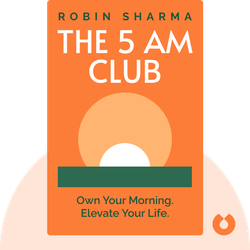Try Blinkist to get the key ideas from 7,000+ bestselling nonfiction titles and podcasts. Listen or read in just 15 minutes.
Start your free trial
Blink 3 of 8 - The 5 AM Club
by Robin Sharma

The Invention of Dating
Labor of Love by Moira Weigel explores the history and evolution of dating in the 20th century. It delves into the cultural and economic factors that shaped our understanding of romantic love and the role gender plays in modern relationships.
The world of dating is much different than the one in which your parents met. Do you know why?
Well, economics certainly played a part. To understand this better, let’s wander back briefly in history to the Industrial Revolution, an event that transformed courtship among the working and middle classes.
Before the late nineteenth century, “dating” as we know it now wasn’t really a thing. Instead, matchmaking was controlled by one’s parents or other relatives. In the 1880s, however, the industrial boom led to an increased need for labor, and many young women moved to cities to work in factories, in shops as salespeople, or as servants. This influx of female workers transformed life in the city. Suddenly, city dwellers could witness a previously rare sight – men and women spending time together in public spaces, even kissing in parks and secluded alleyways.
Couples showed affection in public mainly because they had nowhere else to go. Apartments were small and crowded, leaving little room for privacy; workers on limited incomes couldn’t afford an evening at the theater or other places of entertainment.
In contrast, society’s expanding middle class, built with the new wealth from industrialization, could “call” on each other. This popular method of courtship basically had men competing for the favors of women by visiting them at home.
If a man was interested in a particular woman, he’d show up at her home and knock on her front door. A servant would usually answer and take the man’s name and inform the woman of the “caller.” If the woman was interested in the caller, he’d be invited inside. The pair could then talk, sing and enjoy each other’s company for a time, yet always under supervision.
Such a private ritual reflected the wealth of the growing middle classes. Unlike workers who had to steal time in the shadows in public, wealthier individuals could meet suitors in private.



Labor of Love (2016) is your guide to the history of dating. These blinks walk you through the social, cultural and economic shifts that have shaped modern rituals of courtship and explain the curious fads and fashions of flirtation that have come and gone through the ages.
Labor of Love (2016) explores the history and culture of dating, providing a thought-provoking analysis of how romance intersects with capitalism. Here's why this book is worth reading:
It's highly addictive to get core insights on personally relevant topics without repetition or triviality. Added to that the apps ability to suggest kindred interests opens up a foundation of knowledge.
Great app. Good selection of book summaries you can read or listen to while commuting. Instead of scrolling through your social media news feed, this is a much better way to spend your spare time in my opinion.
Life changing. The concept of being able to grasp a book's main point in such a short time truly opens multiple opportunities to grow every area of your life at a faster rate.
Great app. Addicting. Perfect for wait times, morning coffee, evening before bed. Extremely well written, thorough, easy to use.
Try Blinkist to get the key ideas from 7,000+ bestselling nonfiction titles and podcasts. Listen or read in just 15 minutes.
Start your free trial
Blink 3 of 8 - The 5 AM Club
by Robin Sharma
What is the main message of Labor of Love?
Labor of Love examines the history and sociology of dating, revealing how it has been shaped by economic, social, and cultural forces.
How long does it take to read Labor of Love?
Labor of Love can be read in a few hours, while the Blinkist summary will take just 15 minutes.
Is Labor of Love a good book? Is it worth reading?
Labor of Love is a fascinating exploration of how dating has evolved over time, offering valuable insights to readers interested in relationships and society.
Who is the author of Labor of Love?
Moira Weigel is the author of Labor of Love.